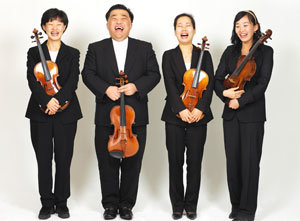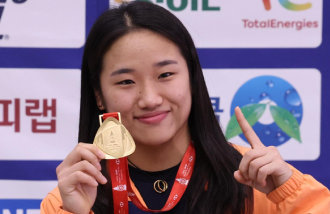Declaration of Independence for the Viola
Declaration of Independence for the Viola
Posted January. 23, 2005 09:24,

Question: How do you keep your violin from getting stolen?
Answer: You put it in a viola case.
This is a viola joke frequently found on Internet string music sites. It mercilessly mocks the violas lack of popularity as an instrument both larger and lower in tone than the violin. But is the viola really just the violins ugly sibling?
In the U.S. and Europe, the viola has increasingly been entering the spotlight since the 1990s. And the number of new compositions being created for the viola is no fewer than those for the violin or the cello. Its because the violas deeper timbre suits the sensibility of the modern individual, who seeks nature and the inner life.
Thus says violist Lee Jung-oh (35). He and his fellow violists Lee Mi-ja (44), Choi Seung-hae (34), and Kim Ha-young (32) have formed a quartet composed exclusively of violas named Quattra Bratsche. They will be holding the quartets inaugural performance at the Ceramic Palace Hall in Ilwon-dong, Gangnam-gu, Seoul at 7:30 p.m. on January 29. Bratsche means viola in German.
Because the viola can produce everything from deep bass notes to high-pitched notes, its possible to form an ensemble using just violas. This alone is enough to tell you what an attractive instrument the viola is, explains Lee Mi-ja.
The violas considerable size and weight makes it difficult for a child to play. Most violists start out learning the violin when young, then convert to the relatively unpopular viola later on. What about the four members of Quattra Bratsche?
Both Lee Mi-ja and Kim Ha-young originally entered college as violin majors, then switched to the viola after being captivated by its sound. Choi Seung-hae is a rare exception who took on the viola as a partner for life when she first began studying music in ninth grade. Lee Jung-oh was also a violinist, but moved on to the viola in 12th grade at his family and friends recommendation that its size was a better fit for a mans physique.
Its true that many people switch from the violin to the viola in order to get into college. Since the violin requires more elaborate techniques, the change actually helps in successfully passing your entrance examination. But Kim warned that its dangerous to change majors without fully appreciating the beauty of the viola, because its lower tone requires you to search for novelty and innovation each day you play.
All four members of Quattra Bratsche are familiar with the viola jokes floating around the internet. A director instructed the viola section to play piano (softly), but the sound was still too loud. So he instructed, solo (just one violist). This time, the whole part was silent because nobody knew who he was referring to.
Choi remarked that some teachers were offended by jokes in this vein back when she was studying abroad, but that they tend to laugh it off nowadays thanks to the violas vastly improved status.
The violinist Pinchas Zuckerman fell in love with the deep allure of the viola, and now performs mainly as a violist. In the 1990s, the emergence of numerous talented violists such as Yuri Bashmet and Nobuko Imai opened a golden age for the viola. Lee noted with emphasis that the leading role in 21st century music will fall to the viola.
The program for Quattra Bratsches inaugural concert will include Bachs Chaconne, Beethovens Trio for Three Violas, and Handels Sonata for Two Violas and Piano. Tickets are 10,000 won each. 02-497-1973
Yoon-Jong Yoo gustav@donga.com



![[속보]신한카드 가맹점 대표 19만명 개인정보 유출](https://dimg.donga.com/c/138/175/90/1/wps/NEWS/IMAGE/2025/12/23/133022917.1.jpg)



